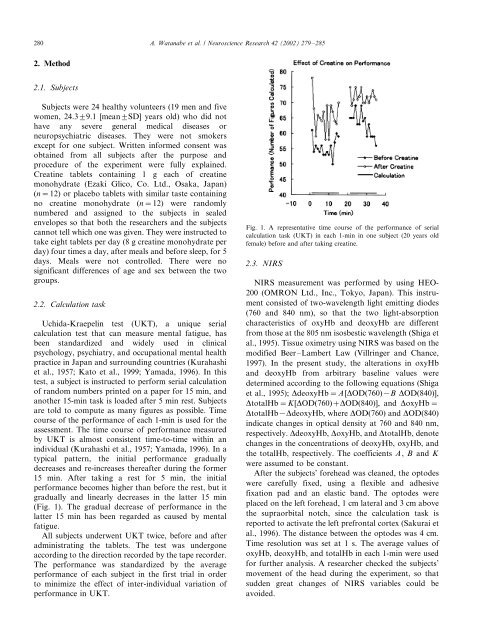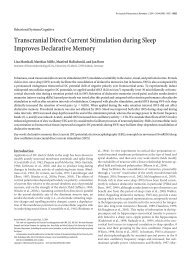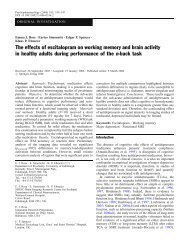Watanabe 2002 - AMA-Marketing
Watanabe 2002 - AMA-Marketing
Watanabe 2002 - AMA-Marketing
You also want an ePaper? Increase the reach of your titles
YUMPU automatically turns print PDFs into web optimized ePapers that Google loves.
280<br />
A. <strong>Watanabe</strong> et al. / Neuroscience Research 42 (<strong>2002</strong>) 279/285<br />
2. Method<br />
2.1. Subjects<br />
Subjects were 24 healthy volunteers (19 men and five<br />
women, 24.39/9.1 [mean9/SD] years old) who did not<br />
have any severe general medical diseases or<br />
neuropsychiatric diseases. They were not smokers<br />
except for one subject. Written informed consent was<br />
obtained from all subjects after the purpose and<br />
procedure of the experiment were fully explained.<br />
Creatine tablets containing 1 g each of creatine<br />
monohydrate (Ezaki Glico, Co. Ltd., Osaka, Japan)<br />
(n/12) or placebo tablets with similar taste containing<br />
no creatine monohydrate (n/12) were randomly<br />
numbered and assigned to the subjects in sealed<br />
envelopes so that both the researchers and the subjects<br />
cannot tell which one was given. They were instructed to<br />
take eight tablets per day (8 g creatine monohydrate per<br />
day) four times a day, after meals and before sleep, for 5<br />
days. Meals were not controlled. There were no<br />
significant differences of age and sex between the two<br />
groups.<br />
2.2. Calculation task<br />
Uchida-Kraepelin test (UKT), a unique serial<br />
calculation test that can measure mental fatigue, has<br />
been standardized and widely used in clinical<br />
psychology, psychiatry, and occupational mental health<br />
practice in Japan and surrounding countries (Kurahashi<br />
et al., 1957; Kato et al., 1999; Yamada, 1996). In this<br />
test, a subject is instructed to perform serial calculation<br />
of random numbers printed on a paper for 15 min, and<br />
another 15-min task is loaded after 5 min rest. Subjects<br />
are told to compute as many figures as possible. Time<br />
course of the performance of each 1-min is used for the<br />
assessment. The time course of performance measured<br />
by UKT is almost consistent time-to-time within an<br />
individual (Kurahashi et al., 1957; Yamada, 1996). In a<br />
typical pattern, the initial performance gradually<br />
decreases and re-increases thereafter during the former<br />
15 min. After taking a rest for 5 min, the initial<br />
performance becomes higher than before the rest, but it<br />
gradually and linearly decreases in the latter 15 min<br />
(Fig. 1). The gradual decrease of performance in the<br />
latter 15 min has been regarded as caused by mental<br />
fatigue.<br />
All subjects underwent UKT twice, before and after<br />
administrating the tablets. The test was undergone<br />
according to the direction recorded by the tape recorder.<br />
The performance was standardized by the average<br />
performance of each subject in the first trial in order<br />
to minimize the effect of inter-individual variation of<br />
performance in UKT.<br />
Fig. 1. A representative time course of the performance of serial<br />
calculation task (UKT) in each 1-min in one subject (20 years old<br />
female) before and after taking creatine.<br />
2.3. NIRS<br />
NIRS measurement was performed by using HEO-<br />
200 (OMRON Ltd., Inc., Tokyo, Japan). This instrument<br />
consisted of two-wavelength light emitting diodes<br />
(760 and 840 nm), so that the two light-absorption<br />
characteristics of oxyHb and deoxyHb are different<br />
from those at the 805 nm isosbestic wavelength (Shiga et<br />
al., 1995). Tissue oximetry using NIRS was based on the<br />
modified Beer/Lambert Law (Villringer and Chance,<br />
1997). In the present study, the alterations in oxyHb<br />
and deoxyHb from arbitrary baseline values were<br />
determined according to the following equations (Shiga<br />
et al., 1995); DdeoxyHb/A[DOD(760)/B DOD(840)],<br />
DtotalHb/K[DOD(760)/DOD(840)], and DoxyHb/<br />
DtotalHb/DdeoxyHb, where DOD(760) and DOD(840)<br />
indicate changes in optical density at 760 and 840 nm,<br />
respectively. DdeoxyHb, DoxyHb, and DtotalHb, denote<br />
changes in the concentrations of deoxyHb, oxyHb, and<br />
the totalHb, respectively. The coefficients A, B and K<br />
were assumed to be constant.<br />
After the subjects’ forehead was cleaned, the optodes<br />
were carefully fixed, using a flexible and adhesive<br />
fixation pad and an elastic band. The optodes were<br />
placed on the left forehead, 1 cm lateral and 3 cm above<br />
the supraorbital notch, since the calculation task is<br />
reported to activate the left prefrontal cortex (Sakurai et<br />
al., 1996). The distance between the optodes was 4 cm.<br />
Time resolution was set at 1 s. The average values of<br />
oxyHb, deoxyHb, and totalHb in each 1-min were used<br />
for further analysis. A researcher checked the subjects’<br />
movement of the head during the experiment, so that<br />
sudden great changes of NIRS variables could be<br />
avoided.




